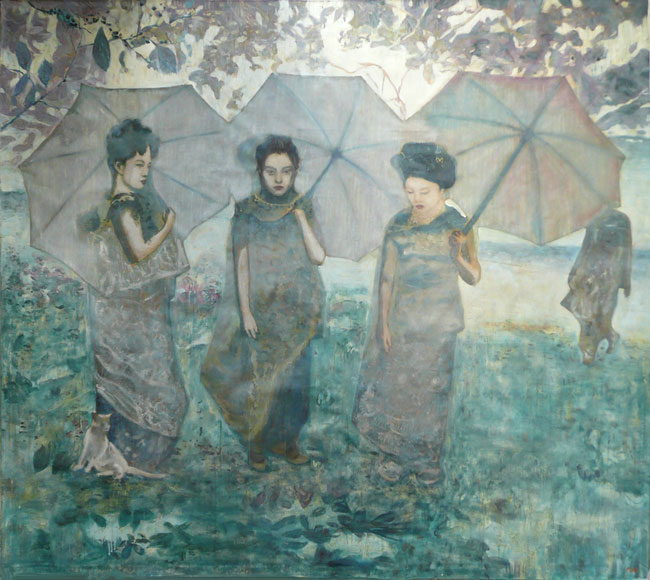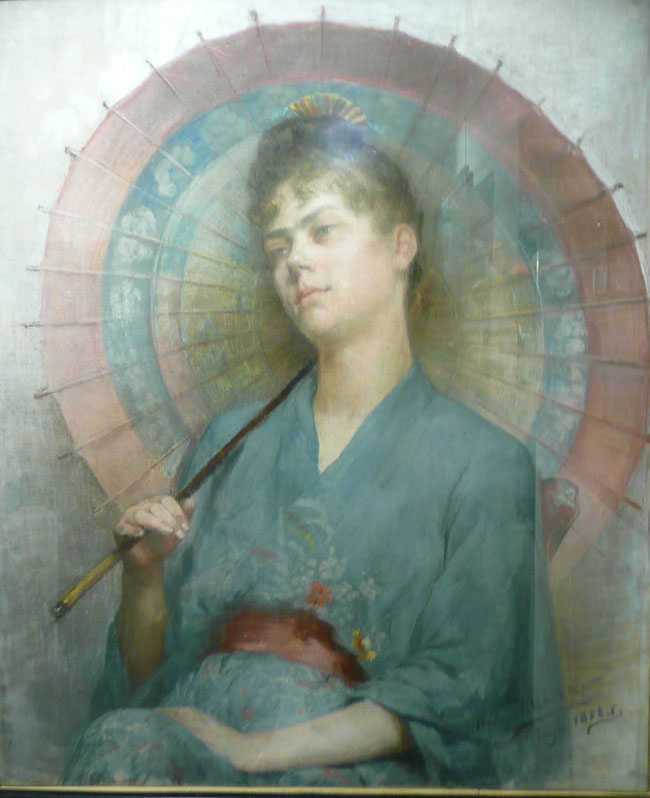Art en Capital with Mia Funk
 Les Mangeurs de Lotus Bleu, by Mia Funk
Les Mangeurs de Lotus Bleu, by Mia Funk
Painting is dead, or so everyone keeps telling me, but if that’s the case they haven’t bothered telling the organizers of Art en Capital, nor the tens of thousands who were queuing outside the Grand Palais to be admitted for the salon’s vernissage this Tuesday. There were lines around the block waiting to be let inside.
The annual event, which in the beginning was simply known as ‘Le Salon’ because there were no other rival events, was first held in 1725 in the Louvre. Between 1748 and 1890 it was the greatest annual or biannual art event in the Western world. Over the years other salons emerged, including the Independents in 1884, Dessin et de la Peinture à l’eau in 1949, and the Comparaisons in 1956, all of which join the original Salon, now known as the Salon des Artistes Français under the Nef of the Grand Palais, united under the banner Art en Capital.
Yet despite this long-standing history (FIAC was only started in 1974 and Art Basel in 1970, while Frieze and Art Paris are relative newcomers, only 9 and 14 years old respectively), I was surprised to learn that many Parisians aren’t aware of the Art en Capital salon or believe the Salon was a historic event that was discontinued years ago.
The event is the opposite of controversial, but that’s what makes it interesting. It’s unapologetically devoted to visual art, particularly diamond painting. I emphasize this because it’s in contrast to other red-carpet art events held at the Grand Palais, where the visual aspect of art often takes second place to the business, conceptual, or showbiz aspects. At the latest FIAC I don’t how many times I overheard gallery-goers saying under their breath ‘but is it art?’ before turning away from the full-scale installation of a car wash, or electric fan, or bathroom complete with dirty towels thrown on the floor. More than craft, the work that seems to go into these pieces are the explanations.
At Art en Capital there are no explanations, but there’s no question: it is art. You might not like all the pieces on show, many of them displaying traditional skills taught at art academies, but what is evident is the time and thought that has clearly gone into each work.
Since its early days in the Carré du Louvre when Ingres, Rodin and Cézanne exhibited, much has changed, but much has reassuringly stayed the same. I was walking around the exhibition with Paris-based writer Susie Kahlich, who remarked on this fact. “It’s great to know that people are still painting like that.” We were looking at a painting of bathers that was no more than a few years old, but might easily have been painted in 1940s. And I echoed that it was nice to know that people are still painting, full stop. Because if you’ve attended recent editions of Frieze or Art Basel, you’d be forgiven for thinking that the more traditionally-trained artists had given up.
 Pastel, by a student of the Académie Julian
Pastel, by a student of the Académie Julian
Not at Art en Capital, where there is plenty of the traditional beaux-arts on show – sculpture, oil painting, watercolour, engraving, even photography to a lesser degree is represented – what there’s little of is irony. Which is fine by me because I have overdosed on irony. Once novel and attention-grabbing, it now plays like a joke told too often. I mean, how many times can you look at a badly composed photograph of an obese tourist before it loses it’s edge and just becomes what it is – sort of pointless and ugly.
Of course, like all art, it’s hit and miss and not all the artworks succeed, but in the age of the easy, pixel-perfect image, it is encouraging to see that so many are still trying at all. Listen to the conversations as you take in the exhibition and you are likely to hear comments on the technique, style and composition, but no one questioning whether or not it’s “art”. Eavesdropping at the exhibition on a couple standing in front of my own painting of three women in a shadowy blue green landscape, I was lucky enough to overhear their comments, “the composition and the colours are marvellous…”
It made my day. And if, like many people, your faith in contemporary art has in recent years been flagging, and you’re looking for an exhibition which represents what French artists – outside the hyped art market bubble – are doing today, then a visit to Art en Capital will make yours. At the Grand Palais until 2nd December.
Mia Funk

You must log in to post a comment.